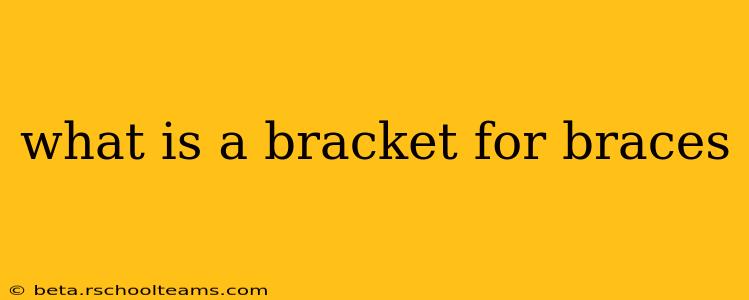The term "bracket for braces" might seem redundant at first glance, but it highlights a crucial component of orthodontic treatment. While the colloquial term "braces" refers to the entire system, a bracket is a small, custom-made device that's specifically attached to each individual tooth. Understanding the bracket's role is key to grasping how braces work.
What Exactly is a Bracket in Orthodontics?
A bracket is a small, metal, ceramic, or plastic square or rectangular device that's precisely bonded to the surface of each tooth. These brackets act as anchors for the archwire, the flexible wire that runs along the length of your teeth. The archwire applies gentle pressure to the brackets, which in turn, slowly moves your teeth into their ideal positions. Think of the brackets as the handles, and the archwire as the tool that guides the movement.
Different types of brackets exist, each with its own advantages and disadvantages:
- Metal Brackets: These are the most common and typically the most affordable. They are durable and effective.
- Ceramic Brackets: These brackets are tooth-colored, making them less noticeable than metal brackets. However, they can be more prone to breakage and are generally more expensive.
- Lingual Brackets: These are placed on the inside of your teeth, making them completely invisible from the outside. However, they can be more difficult to clean and may cause more irritation to the tongue.
How are Brackets Attached to Teeth?
The process of attaching brackets involves several steps:
- Teeth Cleaning: The teeth are thoroughly cleaned to ensure a strong bond.
- Etching: A special etchant is applied to the enamel to roughen the surface, creating a better bond for the adhesive.
- Bracket Placement: The brackets are carefully positioned and bonded to each tooth using a special dental adhesive.
- Curing: A special light is used to cure the adhesive, ensuring a strong and long-lasting bond.
What are the Different Parts of a Bracket?
While the overall shape is relatively simple, understanding the bracket's components further clarifies its function:
- Base: The flat part of the bracket that adheres to the tooth's surface.
- Wings or Brackets: Small projections on the sides of the base that provide extra strength and stability.
- Slot: A small groove or channel in the bracket that receives the archwire.
Why are Brackets Important for Orthodontic Treatment?
Brackets are the cornerstone of orthodontic treatment. Without them, the archwire wouldn't have a place to grip and apply the necessary force to move the teeth. The precise placement and bonding of each bracket is critical for achieving the desired outcome.
What Happens if a Bracket Breaks or Comes Off?
If a bracket breaks or comes off, it's crucial to contact your orthodontist as soon as possible. The missing bracket could interfere with the overall treatment plan and delay the process. Your orthodontist will assess the situation and either rebond the bracket or replace it entirely.
How are Brackets Different from Other Orthodontic Appliances?
While brackets are the most common component of traditional braces, other appliances exist, such as Invisalign aligners. These aligners use a series of clear plastic trays to gently move teeth instead of using brackets and wires. Each option has its advantages and disadvantages, and the best choice depends on individual needs and preferences.
This comprehensive overview provides a thorough understanding of the function and importance of brackets in orthodontic treatment, answering many common questions surrounding this crucial part of braces. Remember to consult with your orthodontist for personalized advice and treatment.
